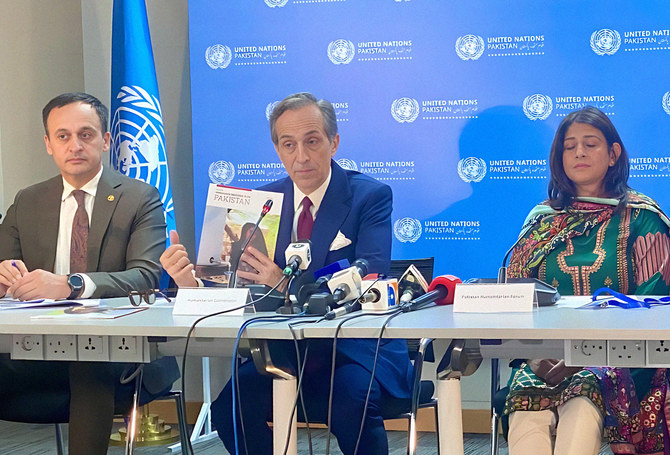
ISLAMABAD : The United Nations agencies on Wednesday vowed to scale up rehabilitation process in the flood-hit areas of Pakistan to meet the growing challenges of health, food, nutrition, clean water and shelter while seeking further financial assistance from international community.
During a joint press talk here, UN Humanitarian Coordinator Julien Harneis said the revised flash appeal launched to respond to the needs of people affected by unprecedented climate-induced floods had increased fivefold symbolising the growing magnitude of the devastation, moving from USD 160 million to USD 816 million.
He was flanked by UN Food and Agriculture Organization (FAO) Deputy Representative Farrukh Toirov, Dr Farah Naureen of Mercy Corporation representing the Pakistan Humanitarian Forum, and UN Office for the Coordination of Humanitarian Affairs (OCHA) Senior Humanitarian Officer Felix Omunu.
Harneis said the UN agencies were making all-out efforts to tackle the situation in the most-affected 84 districts, adding that they were facing alarming situation after multiple diseases were on the rise, especially malaria, diarrhea and skin infections. “Pakistan may see 2.7 million malaria cases in 32 districts by January 2023, while 5.74 million are in phase 3 & 4 of malnutrition (phase 5 is famine).”
He said 8.2 million people were in dire need of health facilities in those areas and it required 114.5 million dollars.
Harneis further said the UN and Pakistan jointly appealed in Geneva for more assistance for the flood victims and hoped they would get it soon from the international community and donors.
“Pledges received so far are more than USD 180 (about 20% of the total appeal), however, only 90 million have been committed with the UN. The pace of the committed amount has slowed in the past two weeks.”
FAO Deputy Representative Farrukh Toirov said the agricultural sector of Pakistan had been devastated, resulting in the loss of critical infrastructure, standing crops, grain storage and livestock rearing.
According to the FAO-GIS team data, around 9.4 million acres of standing “Kharif” crops were washed away, causing food shortage in the country, he said, adding that there were more than 353,000 small farms in the affected areas and if they were not able to sow the seeds in time, it would directly impact the food basket for the whole country.”
He said to address the food insecurity, agriculture sector would be given priority in provision of cash assistance as the international price for fertilizers was quite high and although efforts were made to reduce the international prices of the fertilizers, they were still unaffordable for farmers who already had nothing.
It would be followed by livestock vaccination and treatment, animal feed, crop inputs, rehabilitation of animals shelters, agricultural irrigation channels and community restoration and household-level assets, he added.
Appealing to the world to “please speed up the response,” the FAO rep said livestock were important assets for people in the affected areas. “More than 1.1 million livestock was lost which means hundreds of thousands of families, who needed these for their sustenance and livelihood, had lost their major source of income and food. FAO is providing vaccination and fodder for the livestock. We are responding with what we have but it is not enough.”
Representative of the Pakistan Humanitarian Forum Dr Farah Naureen said the main hurdle in carrying out rehabilitation activities was the unavailability of accurate data about flood damages and infectious diseases. However, she added, measles campaign was underway and large numbers of mobile camps had been set up so far.
She said emergency and mobile medical camps were also set up in different districts to facilitate pregnant women. “More work would be done in this regard.”
She said around 55 million people were badly affected by floods, of which 3 million were using unsafe water, exposing themselves to various types of water-borne diseases.


